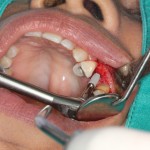
Placement of dental implants immediately after tooth extraction has been recommended by some authors as there are perceived to be a number of advantages, for exampled fewer surgical sessions, good axial positioning enhanced hard and soft tissues maintenance. However, the literature is conflicting regarding the outcomes compared with the standard approach to implant placement.
The aim of this review was to compare the survival rate of dental implants, postoperative infection, and marginal bone loss of dental implants inserted in fresh extraction sockets and in healed sites.
Methods
The PubMed, Web of Science, and the Cochrane Oral Health Group Trials Register databases were searched together with a range of dental implants-related journals and ongoing trials databases (clinicaltrials.gov; www.centerwatch.com/clinicaltrials; www.clinicalconnection.com ). Human clinical studies that compared implant failure rates in any group of patients receiving dental implants being inserted in fresh extraction sockets compared to the insertion in healed sites were considered. Implant failure for this review was complete loss of the implant.
Study selection was by three reviewers with quality being assess using the Newcastle–Ottawa scale (NOS). The main outcomes considered were implant failure and postoperative infection
Results
- 73 papers were included (5 Randomised controlled trials, 26 clinical controlled trials; 42 retrospective studies)
- 8,241 implants were inserted in fresh sockets with 330 failures (4.00%)
- 19,410 implants were inserted in healed sites with 599 failures (3.09%)
- Random effects meta-analysis (73 studies) found a relative risk of implant failures in fresh socket sites compared to healed sites was RR= 1.58 (95% CI; 1.27–1.95)
- For maxillae only RR= 1.61 (95% CI; 0.97–2.66)
- For mandible only RR= 2.15 (95% CI; 0.62-7.47)
- With single crown restoration RR= 2.05 (95% CI; 1.36-3.11)
- With full arch prosthesis RR= 1.42 (95% CI; 0.71- 2.83)
- When only the controlled studies (CCTs) and randomised controlled (RCTs) studies are considered:-
- 2021 implants were inserted in fresh sockets with 96 failures (4.75%)
- 2759 implants were inserted in healed sites with 49 failures (1.59%)
- Relative risk of implant failures in fresh socket sites compared to healed sites was RR= 2.27 (95% CI; 1.57-3.29)
Conclusions
The authors concluded
The results of the present review should be interpreted with caution due to the presence of uncontrolled confounding factors in the included studies most of them not randomized trials. Within the limitations of the existing investigations, the present study suggests that the insertion of dental implants in fresh extraction sockets affects the implant failure rates.
Commentary
As the authors themselves point out the findings of this review should be interpreted with caution due to uncontrolled confounding factors in the included studies. It is perhaps surprising then given that there were a reasonable number of controlled and randomised controlled trials that they decided to include the retrospective studies which are likely to be at higher risk of bias. The fact that the meta-analysis that only included the better quality studies suggested a higher failure rates for implants placed in fresh sockets may suggest that this is the case but the number of included randomised controlled trials is small at 5 and they only include the placement of a small number of implants in total (282).
This is another one of a series of dental implants reviews from these authors see Dental Elf- 5th Dec 2014 for further links.
Links
Chrcanovic BR, Albrektsson T, Wennerberg A. Dental implants inserted in fresh extraction sockets versus healed sites: A systematic review and meta-analysis. J Dent. 2014 Nov 26. pii: S0300-5712(14)00327-3. doi: 10.1016/j.jdent.2014.11.007. [Epub ahead of print] Review. PubMed PMID: 25433139.

[…] BR, Albrektsson T, Wennerberg A. Dental implants inserted in fresh extraction sockets versus healed sites: A systematic review and me… J Dent. 2014 Nov […]
[…] Dental Elf – 12th Dec 2014 – Dental implants placed in fresh sockets have higher failure… […]
[…] Dental Elf – 12th Dec 2014 – Dental implants placed in fresh sockets have higher failure rat… […]
[…] Dental Elf -12th Dec 2014 – Dental implants placed in fresh sockets have higher failure rates … […]
[…] https://www.nationalelfservice.net/dentistry/restorative-dentistry/dental-implants-placed-in-fresh-s… […]